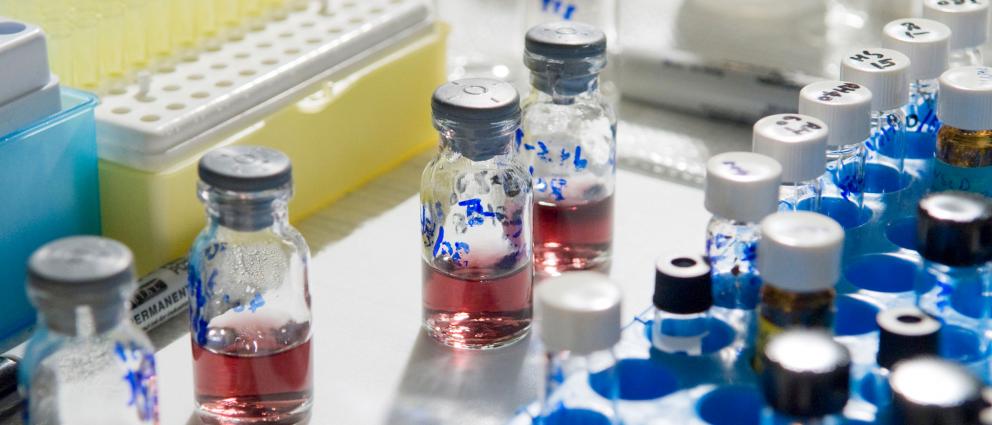Research Overview—
Microanalytical methods for the investigation of the transport and metabolism of peptides across the blood-brain barrier: An insight into peptide transport and metabolism is important for effective drug design and the understanding of neurological disorders. Crucial to these studies is the development of analytical methodologies that are capable of monitoring these biologically important compounds at physiologically relevant concentrations. The particular analytes of interest include neuroactive peptides, amino acids and catechol¬amines. Release, transport, and metabolism of these substances can be investigated in vitro using a cell culture model or in vivo using microdialysis sampling. Due to the small sample volumes generated by these methods, microcolumn-based separation methods have been employed for analysis. These include capillary and microchip electrophoresis and microcolumn liquid chromatography. To obtain the requisite sensitivity for these assays, laser-induced fluorescence and electrochemical detection and mass spectrometric methods have been employed. The focus of this research has been primarily on substance P and dynorphin. These two neuropeptides have been shown to be important in neuropathic and chronic pain as well as depression. Separation-based sensors based on microdialysis coupled to microchip electrophoresis: The second project area concerns the development of on-animal separation-based sensors for near real-time monitoring of drugs and neurotransmitters in awake, freely roaming animals. The on-line coupling of microdialysis with capillary electrophoresis yields a sensor capable of monitoring multiple analytes simultaneously during pharmacological and neurochemical studies involving awake, freely moving animals. However, current on-line systems are rather large and generally take up an entire lab bench. In addition, the animal is tethered to the syringe pump and analytical system with tubing. In many cases, for example, behavioral studies, one would like to be able to obtain information regarding neurotransmitter release from a freely roaming, untethered animal. With this goal in mind, our group has been focusing their efforts on miniaturization of all the components of the on-line microdialysis-capillary electrophoresis system to produce an on-animal sensor. This includes the development of a chip-based interface between microdialysis sampling and microchip electrophoresis and miniaturization of the detector and associated electronics, as well as the use of telemetry to send the signal to a remote data acquisition station. The primary focus has been on the use of electrochemical detection because both the detector (electrodes) and the potentiostat can be easily miniaturized. Cell-based assays on chips: Along with the development of on-animal sensors, our group has recently begun to investigate cellular assays on chips. Due to the small (micron-to-submicron) dimensions and nanoliter volumes characteristic of the microchip format, very fast analyses can be performed on small volumes. Therefore, it is possible to analyze the content of single cells and/or monitor the release of biologically active compounds from cells integrated into the chip. Current efforts in our laboratory are focused on the development of methods for the detection of reactive oxygen species released from macrophages and bovine brain microvessel endothelial cells. A method for the detection of peroxynitrite using microchip electrophoresis with electrochemical detection has been developed. Chip-based clinical diagnostics: Lastly, the use of capillary electrophoresis/electrochemistry for clinical assays is being investigated. Microchips have several advantages for clinical assays since sample preparation and analysis steps can be integrated onto a single chip. The chips can also be made disposable, obviating problems of cross-contamination. One particular analyte of interest is plasma homocysteine, which has been proposed to be a potential early indicator of heart disease. The development of a fast and accurate analytical method that can be incorporated into the clinical laboratory or used for point-of-care testing is the goal of this project.
Research Interests
- Bioanalytical Chemistry
- Liquid Chromatography
- Capillary Electrophoresis
- Electrochemical and Laser-Induced Fluorescence Detection
- Microdialysis Sampling
- Neurochemistry
- Protein and Peptide Analysis
- Microchip Analytical Systems
- Mass Spectrometry and Anticancer Drug Analysis
Selected Publications —
Caruso, G. Fresta, C. G., Siegel, J. M., Wijesinghe, M. B., & Lunte, S. M. (2017). Microchip electrophoresis with laser-induced fluorescence detection for the determination of the ratio of nitric oxide to superoxide production in macrophages during inflammation. Analytical and Bioanalytical Chemistry, 409(19), 4529-4538. DOI:10.1007/s00216-017-0401-z
Caruso, G. Fresta, C. G., Martinez-Becerra, F. Antonio, L. Johnson, R. T., de Campos, R. P., Siegel, J. M., Wijesinghe, M. B., Lazzarino, G. & Lunte, S. M. (2017). Carnosine modulates nitric oxide in stimulated murine RAW 264.7 macrophages. Molecular and Cellular Biochemistry, 431(1-2), 197-210. DOI:10.1007/s11010-017-2991-3
Fresta, C. Hogard, M. Caruso, G. Melo Costa, E. Lazzarino, G. & Lunte, S. (2017). Monitoring carnosine uptake by RAW 264.7 macrophage cells using microchip electrophoresis with fluorescence detection. Analytical Methods, 9, 402-408.
Hogard, M. Lunte, C. & Lunte, S. (2017). Detection of reactive aldehyde biomarkers in biological samples using solid phase extraction pre-concentration and liquid chromatography with fluorescence detection. Analytical Methods, 9(12), 1848-1854. DOI:10.139/C6AY03327J
Caruso, G. Distefano, D. A., Parlascino, P. Fresta, C. G., Lazzarino, G. Lunte, S. M., & Nicoletti, V. G. (2017). Receptor-mediated toxicity of human amylin fragment aggregated by short- and long-term incubations with copper ions. Molecular and Cellular Biochemistry, 425(1-2), 85-93. DOI:10.1007/s11010-016-2864-1
Al-Hossaini, A. M., Suntornsuk, L. & Lunte, S. M. (2016). Separation of dynorphin peptides by capillary electrochromatography using a polydiallyldimethylammonium chloride gold nanoparticle-modified capillary. Electrophoresis, 37(17-18), 2297-304. DOI:10.1002/elps.201600006
Oborny, N. J., Costa, E. E., Suntornsuk, L. Abreu, F. C., & Lunte, S. M. (2016). Evaluation of a Portable Microchip Electrophoresis Fluorescence Detection System for the Analysis of Amino Acid Neurotransmitters in Brain Dialysis Samples. Analytical sciences : the international journal of the Japan Society for Analytical Chemistry, 32(1), 35-40. DOI:10.2116/analsci.32.35
Lunte, S. (2015). Electrophoretic Methods for Separation of Peroxynitrite and Related Compounds. In . (Ed.), Peroxynitrite Detection in Biological Media.
Lunte, S. (2015). Principles and Strategies for Microchip Electrophoresis with Amperometric Detection. In . (Ed.), Electrochemical Strategies in Detection Science.
Nuchtavorn, N. Suntornsuk, W. Lunte, S. M., & Suntornsuk, L. (2015). Recent applications of microchip electrophoresis to biomedical analysis. Journal of pharmaceutical and biomedical analysis, 113, 72-96. DOI:10.1016/j.jpba.2015.03.002
de Campos, R. P., Siegel, J. M., Fresta, C. G., Caruso, G. da Silva, J. A., & Lunte, S. M. (2015). Indirect detection of superoxide in RAW 264.7 macrophage cells using microchip electrophoresis coupled to laser-induced fluorescence. Analytical and bioanalytical chemistry, 407(23), 7003-12. DOI:10.1007/s00216-015-8865-1
Saylor, R. A., Reid, E. A., & Lunte, S. M. (2015). Microchip electrophoresis with electrochemical detection for the determination of analytes in the dopamine metabolic pathway. Electrophoresis, 36(16), 1912-9. DOI:10.1002/elps.201500150
Scott, D. E., Willis, S. D., Gabbert, S. Johnson, D. Naylor, E. Janle, E. M., Krichevsky, J. E., Lunte, C. E., & Lunte, S. M. (2015). Development of an on-animal separation-based sensor for monitoring drug metabolism in freely roaming sheep. The Analyst, 140(11), 3820-9. DOI:10.1039/c4an01928h
Saylor, R. A., Reid, E. A., & Lunte, S. M. (2015). Microchip electrophoresis with electrochemical detection for the determination of analytes in the dopamine metabolic pathway. Electrophoresis. DOI:10.1002/elps.201500150
Nuchtavorn, N. Suntornsuk, W. Lunte, S. M., & Suntornsuk, L. (2015). Recent applications of microchip electrophoresis to biomedical analysis. Journal of Pharmaceutical and Biomedical Analysis. DOI:10.1016/j.jpba.2015.03.002
Saylor, R. A., & Lunte, S. M. (2015). A review of microdialysis coupled to microchip electrophoresis for monitoring biological events. Journal of chromatography. A, 1382, 48-64. DOI:10.1016/j.chroma.2014.12.086
Saylor, R. A., & Lunte, S. M. (2015). A review of microdialysis coupled to microchip electrophoresis for monitoring biological events. Journal of chromatography. A, 1382, 48-64. DOI:10.1016/j.chroma.2014.12.086
Meneses, D. Gunasekara, D. B., Pichetsurnthorn, P. da Silva, J. A., de Abreu, F. C., & Lunte, S. M. (2015). Evaluation of in-channel amperometric detection using a dual-channel microchip electrophoresis device and a two-electrode potentiostat for reverse polarity separations. Electrophoresis, 36(3), 441-8. DOI:10.1002/elps.201400297
Lucca, B. G., Lunte, S. M., Tomazelli Coltro, W. K., & Ferreira, V. S. (2014). Separation of natural antioxidants using PDMS electrophoresis microchips coupled with amperometric detection and reverse polarity. Electrophoresis, 35(23), 3363-70. DOI:10.1002/elps.201400359
Gunasekara, D. B., Siegel, J. M., Caruso, G. Hulvey, M. K., & Lunte, S. M. (2014). Microchip electrophoresis with amperometric detection method for profiling cellular nitrosative stress markers. The Analyst, 139(13), 3265-73. DOI:10.1039/c4an00185k
Metto, E. C., Sharma, A. Evans, K. Culbertson, A. H., Caruso, C. Hulvey, M. K., daSilva, J. F., Lunte, S. M., & Culbertson, C. T. (2013). Integrated microfluidic device for monitoring nitric oxide in single T-lymphocytes . Analytical Chemistry, 85(21), 10188-95.

